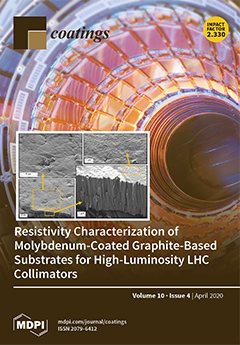A polyurethane (PU)-based powder coating reinforced with vinyltrimethoxysilane (VTMS)-functionalized ZrO
2 nanoparticles (V-ZrO
2) for thermal stability was developed. Chemical structure, microstructure and thermal degradation kinetics of the prepared coatings were investigated. The peak of aliphatic C–H vibrating bond in the Fourier
[...] Read more.
A polyurethane (PU)-based powder coating reinforced with vinyltrimethoxysilane (VTMS)-functionalized ZrO
2 nanoparticles (V-ZrO
2) for thermal stability was developed. Chemical structure, microstructure and thermal degradation kinetics of the prepared coatings were investigated. The peak of aliphatic C–H vibrating bond in the Fourier transform infrared (FTIR) spectrum of V-ZrO
2 was a signature of VTMS attachment. Scanning electron microscopy (SEM) images reveled that, by increase of V-ZrO
2 content from 0.1 to 0.3 wt.% and then 0.5 wt.%, some agglomerations of nanoparticles are formed in the PU matrix. Thermogravimetric analysis (TGA) of the PU/V-ZrO
2 powder coatings was performed at different heating rates nonisothermally to capture alteration of activation energy (
Ea) of degradation of PU/V-ZrO
2 powder coatings as a function of partial mass loss by using
Friedman,
Kissinger–Akahira-Sunose (
KAS),
Ozawa–Wall–Flynn (
FWO) and modified
Coats–Redfern isoconversional approaches. It was observed that by addition of 1 wt.% V-ZrO
2 to PU resin the early state degradation temperature at 5% weight loss increased about 65 °C, suggesting a physical barrier effect limiting the volatility of free radicals and decomposition products. Incorporation of 5 wt.% ZrO
2 led to about 16% and 10% increase in
Ea and
LnA of blank PU, respectively, which was indicative of higher thermal resistance of nanocomposite powder coatings against thermal degradation. There was also obvious agreement between model outputs and experimental data. The results reveal that nanocomposite coating shows superior thermal properties compared to neat PU powder coatings, and the presence of nano ZrO
2 in sufficient amount causes retardation of the thermal decomposition process.
Full article





